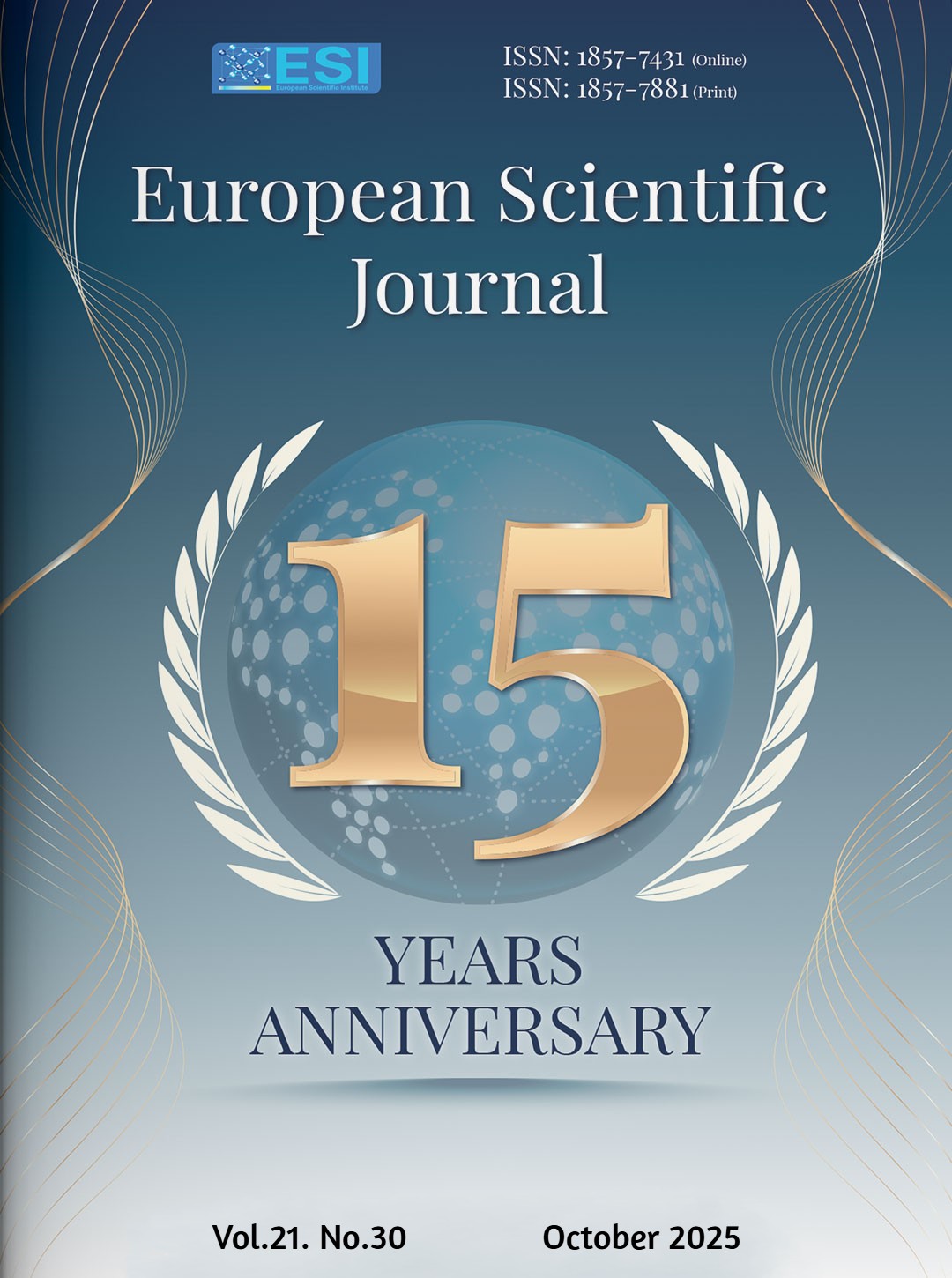Évaluation Comparative des Effets Anthropométriques de l’Huile de Palme, de l’Huile d’Olive Extra Vierge et de l’Huile d’Olive Contaminée par de l’Huile de Croton chez le Rat Wistar
Abstract
L’huile de palme et l’huile d’olive sont largement utilisées pour leurs propriétés nutritionnelles, bien que l’huile de palme soit souvent critiquée pour sa teneur en acides gras saturés. L’huile de croton, quant à elle, possède des effets thérapeutiques lorsqu’elle est administrée sous stricte surveillance médicale. Cette étude vise à comparer les effets anthropométriques de la consommation quotidienne de quatre huiles végétales, huile d’olive extra vierge, huile d’olive contaminée par 1 % d’huile de croton, huile de palme brute et huile de palme raffinée sur des rats Wistar, afin d’évaluer leur impact nutritionnel et métabolique. Soixante rats Wistar (mâles et femelles) ont été répartis en cinq groupes (n = 12) et soumis pendant six mois à des régimes alimentaires spécifiques : granulés seuls (GSH), granulés enrichis à 20 % d’huile d’olive (HO), à 20 % d’huile d’olive contaminée par 1 % d’huile de croton (HC Dil.100×), à 20 % d’huile de palme brute (HPB), et à 20 % d’huile de palme raffinée (HPR). Les paramètres évalués incluaient le poids corporel, la consommation alimentaire, l’hydratation, la digestibilité, ainsi que les efficacités protéique et énergétique. Le groupe GSH a présenté les meilleures performances nutritionnelles : gain pondéral significatif (1247 ± 13,2 g), digestibilité élevée (ID : 1,059 ± 0,07), efficacité protéique (EP : 0,02101 ± 0,0007) et énergétique (EE : 38,33 ± 1,19). Les groupes HO et HC Dil.100× ont montré les performances les plus faibles, notamment en efficacité énergétique (respectivement 19,62 ± 0,63 et 16,75 ± 0,80). Des différences hautement significatives ont été observées pour le gain de poids entre le groupe GSH et les groupes supplémentés en huiles (p < 0,0001), tandis que les autres paramètres ne présentaient pas de variations significatives (p > 0,05). La consommation modérée d’huile de palme, qu’elle soit brute ou raffinée, n’induit pas de prise de poids excessive chez le rat Wistar et semble compatible avec une alimentation équilibrée. En revanche, l’ajout d’huile de croton à l’huile d’olive altère les performances nutritionnelles, soulignant la nécessité d’une surveillance stricte de son usage.
Palm oil and olive oil are widely used for their nutritional properties, although palm oil is often criticized for its high saturated fat content. Croton oil, meanwhile, exhibits therapeutic effects when administered under strict medical supervision. This study aims to compare the anthropometric effects of the daily consumption of four vegetable oils, extra virgin olive oil, olive oil contaminated with 1% croton oil, crude palm oil, and refined palm oil, on Wistar rats, in order to assess their nutritional and metabolic impact. Sixty Wistar rats (male and female) were randomly assigned to five groups (n = 12) and fed for six months with specific diets: pellets alone (GSH), pellets enriched with 20% olive oil (HO), 20% olive oil contaminated with 1% croton oil (HC Dil.100×), 20% crude palm oil (HPB), and 20% refined palm oil (HPR). The parameters evaluated included body weight, food intake, hydration, digestibility, and protein and energy efficiency. The GSH group showed the best nutritional performance, with a significant weight gain (1247 ± 13.2 g), high digestibility (ID: 1.059 ± 0.07), and superior protein (EP: 0.02101 ± 0.0007) and energy efficiency (EE: 38.33 ± 1.19). In contrast, the HO and HC Dil.100× groups exhibited the lowest performance, particularly in energy efficiency (19.62 ± 0.63 and 16.75 ± 0.80, respectively). Highly significant differences in weight gain were observed between the GSH group and the oil-supplemented groups (p < 0.0001), while other parameters showed no significant variation (p > 0.05). Moderate consumption of palm oil, whether crude or refined, did not lead to excessive weight gain in Wistar rats and appears compatible with a balanced diet. However, the addition of croton oil to olive oil negatively affected nutritional performance, highlighting the need for strict supervision of its use.
Downloads
Metrics
PlumX Statistics
References
2. Bellisle, F. (2005). Glucides, appétit et prise alimentaire. Cahiers de Nutrition et de Diététique, 40(3), 129–134.
3. Berenblum, I. (1941). The cocarcinogenic action of croton oil. Journal of Cancer Research, 1(1), 44–48.
4. Blundell, J. E., Burley, V. J., & Cotton, J. R. (1993). Dietary fat and the control of energy intake. American Journal of Clinical Nutrition, 57(5), 772S–778S.
5. Bohué, A. I. H., Kamagaté, A., & Yapo, A. P. (2016). Prévalence à l’obésité par la consommation modérée d’huile de palme chez le rat. European Scientific Journal, 12(30), 224-242.
6. Čmolík, J. (2000). Physical refining of edible oils. European Journal of Lipid Science and Technology, 102(7), 472–475.
7. De Castro, J. M. (1987). Macronutrient relationships with meal patterns and mood in the free-living human. Physiology & Behavior, 39(4), 561–567.
8. Edem, D. O. (2000). Palm oil: Biochemical, physiological, nutritional, hematological, and toxicological aspects. Plant Foods for Human Nutrition, 55(4), 319–341.
9. Edem, D. O. (2002). Nutritional and medicinal value of palm oil. Journal of Applied Sciences and Environmental Management, 6(1), 25–29.
10. EU (1986). « Council Directive 86/609/EEC of 24 November 1986 on the approximation of laws, regulations and administrative provisions of the Member States regarding the protection of animals used for experimental and other scientific purposes», Official Journal, vol. L 358, pp. 1–28. [Online] Available: https://eur-lex.europa.eu/legal-content/EN/ALL/?uri=celex%3A31986L0609 (10 Octobre, 2023).
11. FAO (2008). Fats and fatty acids in human nutrition: Report of an expert consultation. FAO Food and Nutrition Paper No. 91. [Consulté le 17 septembre 2025]
12. Hetter, K. (2000a). Palm oil and cardiovascular disease: Part I. Journal of Nutrition and Health, 16(2), 101–108.
13. Hetter, K. (2000b). Palm oil and cardiovascular disease: Part II. Journal of Nutrition and Health, 16(3), 109–115.
14. Hutchinson, J. (1833). On the botanical classification of Tridax procumbens. Transactions of the Linnean Society, 17(2), 221–230.
15. Johnson, S. L., Mander, A. P., Jones, L. R., Emmett, P. M., & Jebb, S. A. (1993). Energy density and its role in the control of food intake. International Journal of Obesity, 17(11), 769–777.
16. Lang, V., Bellisle, F., & Oppert, J. M. (1998). Satiating power of proteins in mixed meals. Appetite, 30(1), 45–54.
17. Lawton, C. L., Burley, V. J., Wales, J. K., & Blundell, J. E. (2000). Dietary fat and appetite control in obese subjects. American Journal of Clinical Nutrition, 71(5), 1013–1021.
18. Lecerf, J. M. (2016). Effets métaboliques des acides gras saturés. HAL Archives Ouvertes. https://hal.archives-ouvertes.fr/hal-01345678 (Consulté le 17 septembre 2025).
19. Lombard, J. (2024). Palm oil and public health: A balanced perspective. Global Journal of Nutrition Science, 18(2), 112–120.
20. Lombard, P. (2017). La vérité sur l’huile de palme. LaNutrition.fr. Mis à jour le 21 août 2017. Disponible sur : https://www.lanutrition.fr/bien-dans-son-assiette/les-nutriments/lipides/la-verite-sur-lhuile-de-palme (Consulté le 17 septembre 2025)
21. Ludwig, D. S., et al. (1999). High glycaemic index foods, overeating, and obesity. Pediatrics, 103(3), e26.
22. Mba, O. I., Dumont, M. J., & Ngadi, M. (2015). Palm oil: Processing, characterization and utilization. Food Bioscience, 10, 26–41.
23. Newton, A. C. (2001). Protein kinase C: structural and spatial regulation. Chemical Reviews, 101(8), 2353–2364.
24. Nti, C. A., & Osei, S. A. (2024). Nutritional evaluation of palm oil in rodent models. African Journal of Food Science, 18(1), 33–41.
25. Ong, A. S. H., Goh, S. H., & Choo, Y. M. (2007). Palm oil tocotrienols in cardiovascular health. Asia Pacific Journal of Clinical Nutrition, 16(3), 421–427.
26. Pérez, C., Bellisle, F., & Féré, C. (1994). Sweet taste and food intake in humans. Appetite, 23(1), 1–11.
27. Porrini, M., et al. (1997). Effects of food characteristics on satiety. Physiology & Behavior, 62(3), 475–481.
28. Read, N. W. (1992). Dietary fat and gastrointestinal function. Proceedings of the Nutrition Society, 51(1), 13–23.
29. Reid, M., Hammersley, R., & Hill, A. (1994). Food deprivation and cravings. Appetite, 23(3), 231–246.
30. Rolls, B. J., Bell, E. A., & Waugh, B. A. (1995). Food volume and satiety. American Journal of Clinical Nutrition, 62(3), 511–518.
31. Saadatian-Elahi, M., Norat, T., Goudable, J., & Riboli, E. (2004). Biomarkers of dietary fatty acid intake and the risk of breast cancer: A meta-analysis. International Journal of Cancer, 111(4), 584–591.
32. Sambanthamurthi, R., Sundram, K., & Tan, Y. A. (2000). Chemistry of palm oil. Progress in Lipid Research, 39(6), 507–558.
33. Sczaniecka, A., Rehm, C. D., & Drewnowski, A. (2012). Nutrient density and food cost. BMC Public Health, 12(1), 1–8.
34. Sen, C. K., Khanna, S., & Roy, S. (2007). Tocotrienols: Vitamin E beyond tocopherols. Life Sciences, 78(18), 2088–2098.
35. Souganidis, E., Koutelidakis, A., & Zampelas, A. (2013). Palm oil and health: A review of current evidence. Journal of Lipid Research, 54(4), 1041–1052.
36. Tiahoun, A. (2006). Étude ethnobotanique et pharmacologique de Tridax procumbens. Revue Ivoirienne de Médecine Traditionnelle, 4(1), 22–30.
37. Veillet, S. (2010). Effets des acides gras saturés sur la santé cardiovasculaire. Thèse de doctorat, Université de Montréal, Canada.
38. Zhou, Y., Li, X., & Chen, H. (2023). Comparative metabolic effects of refined and crude palm oil in rodents. Journal of Nutritional Biochemistry, 110, 109–118.
Copyright (c) 2025 Augustin Nicolas Agnimel, Adama Kamagate

This work is licensed under a Creative Commons Attribution 4.0 International License.








